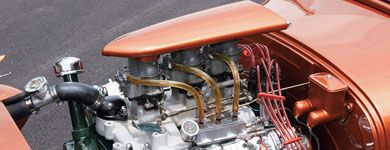
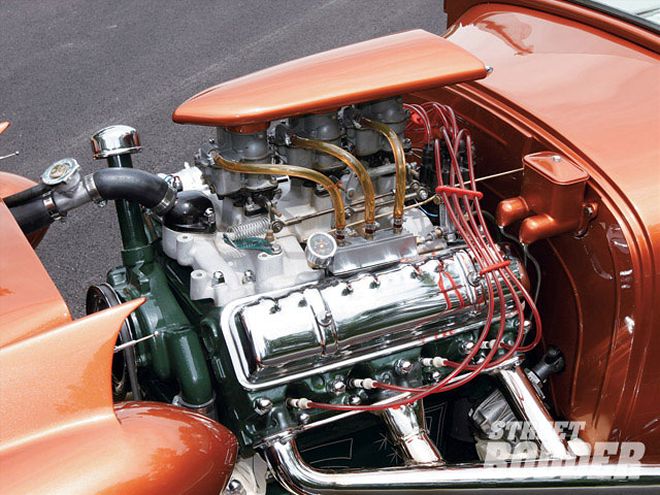 Today you'll find Rocket power occupying the engine bays of everything from trad-rods to custom/show rods like this one by Tom Culbertson, which exemplifies how these "obsolete" engines look far more impressive than any crate motor with fake Olds valve covers.
Today you'll find Rocket power occupying the engine bays of everything from trad-rods to custom/show rods like this one by Tom Culbertson, which exemplifies how these "obsolete" engines look far more impressive than any crate motor with fake Olds valve covers.
In some ways, the Oldsmobile V-8s produced in the '50s and early '60s period we've been examining in this series have been the opposite of the Buick nailheads in their connection to hot rodding, then and now. We're seeing more nailheads in street rods today than ever before, while the Oldsmobile motors were very popular with hot rodders and racers from their very introduction, yet we don't see that many powering modern-built hot rods. Sit down sometime and peruse a stack of old enthusiast magazines and you'll notice that Olds V-8s were perhaps the most popular upgrade for a Flathead rod or custom, and during the same decade, say 1953-1963, Hot Rod magazine drag results could give you insight into the competition utilization of Rockets.
When Charles F. Kettering developed the Hydra-Matic automatic transmission for the 1940 Olds, this was just the beginning for this genius engineer who spent some 31 very productive years in GM Research. The introduction of the "Rocket 8" V-8 for the 1949 Oldsmobiles was perhaps the pinnacle of his achievements, incorporating in its overhead-valve design such features as five main bearings, hydraulic lifters, electric starter (he founded Delco, by the way), modern ignition system, floating piston pins, and high compression. He even helped develop the higher-octane gasoline his engines would need.
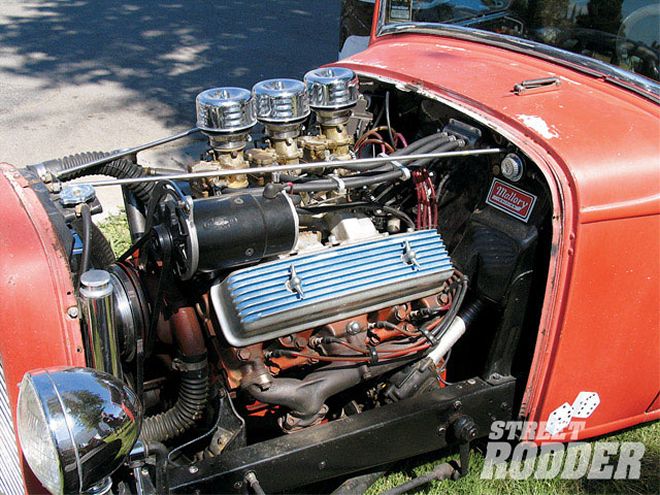 Olds fans die hard. They liked the motors back when and still do, as in this period channeled Deuce five-window, which has been running since the early '60s exactly as you see it here, with triples, generator, and cast-iron exhaust manifolds. Nothing has been "made" to look old; it's a survivor that always been driven regularly. Note custom motor mounts.
Olds fans die hard. They liked the motors back when and still do, as in this period channeled Deuce five-window, which has been running since the early '60s exactly as you see it here, with triples, generator, and cast-iron exhaust manifolds. Nothing has been "made" to look old; it's a survivor that always been driven regularly. Note custom motor mounts.
Starting with that 1949 "Rocket 88" model, Oldsmobile highlighted the image of performance at a time when their body designs were very similar to low-priced Chevrolets and other GM models. By the mid-'50s and later, Oldsmobile had proven its reputation for power, and switched to touting their ever-advancing styling and comfort in an effort to stay in the rough Detroit competition for the rising middle class. Rodders were the one group who accepted the Olds V-8 for racing and hot rod use from early on, and rode the Rocket right up until the early '60s, when small-block Chevys took over for fast-and-cheap motive power.
The century-long Oldsmobile lineage of car-building has come to a close, but not without some great product. That first Rocket was the Pace Car for the 1949 Indy 500, but Oldsmobile had some racing success long before that. With the OHV V8s of the '50s, they won the NASCAR Manufacturer's Championship in '49, '50, and '51, and great drivers such as Curtis Turner and the three Flock brothers (Bob, Tim, and ex-moonshiner Fonty) were successful throughout the early '50s. Veteran Lee Petty won the first Daytona 500 in 1959 with an Olds, but other marques had bigger engines later on and Oldsmobile wasn't that interested in trying to stay in the racing game as a manufacturer.
The Olds V-8 engines can be considered as three progressive groups: the early '49-56 engines; the late '57-63, and the "new" '64 and later. We'll concentrate on the two former groups, larger "new" Olds engines are great, make no mistake, but the '49-63 are considered to be prime nostalgia-build material. The Rockets debuted with 303 inches and 135 horsepower, then inched up over the years in displacement, with a number of variations in power due to carburetion (2bbl or 4bbl), cam profiles and compression ratio. In each model year, the base 88 models were eclipsed by the "Super 88" and 98 models in horsepower. From '54-56, the standard Olds V-8 was 324 inches (170 to 230 hp), then the 371-incher was brought in for the '57 to '60 "Golden Rocket" model period (270 to 305 hp). Of interest to most hot rodders was the fabled J-2 option of three Rochester deuces and a hotter cam to achieve 325 ponies. For racing use in drags and NASCAR, Oldsmobile offered an "export" package for the J-2, consisting of an Isky E-4 cam, solid lifters, adjustable rockers and forged pistons. And you thought the adoption of aftermarket speed equipment with over-the-counter factory part numbers was new? Such engines had dimpled valve covers to clear the adjustable rockers. Isky obtained a pile of these covers, had them chromed and sold them to hot rodders, so finding these covers on an engine today is no guarantee the rest of the goodies are inside. These Rocket engines were heavier than a SBC, but they stood on some serious pounds-feet of torque. One last displacement increase in 1959 to 394 cubes and a top power rating of 330 horsepower, the "Sky Rocket" rounded out what we're calling the vintage years of Olds engines.
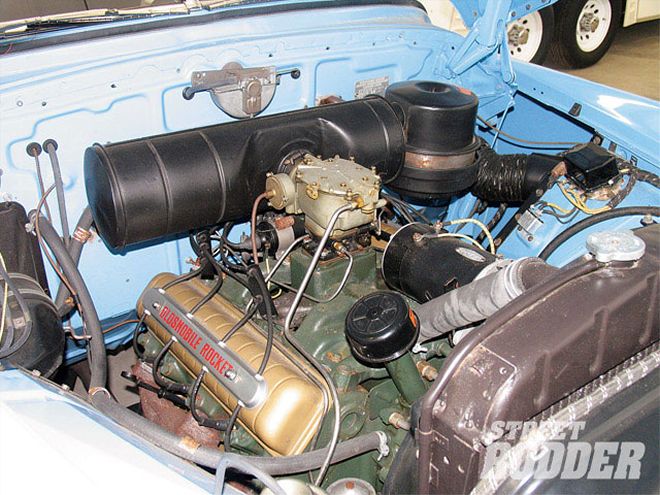 This was the all the buzz in 1949, the first mass-produced OHV V-8, and it offered real performance. As equipped here in Steve Brooks' restored Futuramic 98 it was cool, but when factory engineers suggested offering the same power in the 350-pounds-lighter 88, they fulfilled the promise of the Rocket appellation on the street and track.
This was the all the buzz in 1949, the first mass-produced OHV V-8, and it offered real performance. As equipped here in Steve Brooks' restored Futuramic 98 it was cool, but when factory engineers suggested offering the same power in the 350-pounds-lighter 88, they fulfilled the promise of the Rocket appellation on the street and track.
Hot Rodders And Rockets
With some 5 million Rockets produced from '49-63, they were relatively plentiful for '50s hot rodders to pick up in wrecking yards, and perhaps cheaper that the other hot powerplant choices of the day, such as Hemis, Buicks and Cadillacs, which a wrecking yard might hold aside for the "premium" buyers. Not only was the entry fee reasonable, but the trail of Oldsmobile performance was inevitably smoothed out by the inventive men of the aftermarket speed equipment industry.
Every major camgrinding house had a range of Olds bumpsticks to choose from, in part because the cylinder heads on early Olds were on the low-flow side, and a new cam for $25 was much easier than saving up for head porting at a shop. Although stock four-barrel intakes could be used for a hot rod, the Southern California manifold barons produced every kind of carb setup possible, and their use of aluminum helped trim some ferric cellulite from the Rocket, which usually tipped the scales at 700-725 pounds. Between all the usual suspects, Ansen, Weiand, Trans-Dapt, Wilcap, Cragar, Almquist, Newhouse, and Hildebrandt, cast-aluminum engine-to-trans adapters were offered that simplified exchanging an old flathead for OHV Rocket power in your early Ford.
Back in the '50s, the shop's slogan at hot rodding pioneer Ak Miller's Whittier garage was "Power and Speed Equipment for Oldsmobile and Cadillac." Ak tweaked his '49 Olds coupe up from 135 horsepower stock to 265, setting a record of 123-mph at the Salt in 1952, and on 85-octane pump gas, too. He installed one in his street roadster and cleaned up by putting all of his flathead buddies on the trailer. Of course, a few years later his famous El Caballo '27 roadster ran a hopped Rocket powerplant and placed 5th in the 1955 Mexican Road race against a variety of well-heeled entries.
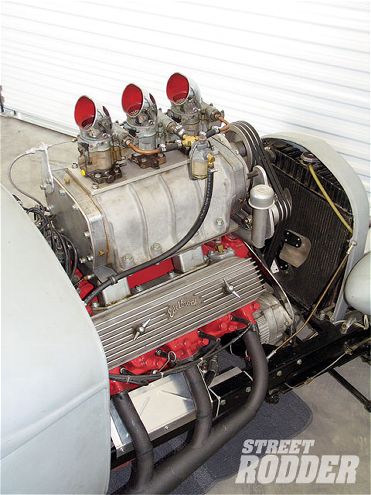 The Rockets were hot in the production 88s, but rodders and racers wasted no time in buying them up as they came into wrecking yards, discovering they could be hopped up readily and also withstand the punishment of racing. Blowers were very popular and compensated for somewhat small ports. Longtime Olds fan Rod Seeman built this one for his roadster with a homemade blower manifold, GMC lung and trio of 97s. It's been driven everywhere.
The Rockets were hot in the production 88s, but rodders and racers wasted no time in buying them up as they came into wrecking yards, discovering they could be hopped up readily and also withstand the punishment of racing. Blowers were very popular and compensated for somewhat small ports. Longtime Olds fan Rod Seeman built this one for his roadster with a homemade blower manifold, GMC lung and trio of 97s. It's been driven everywhere.
Dragsters and lakes cars also found the Olds a competitive candidate for records. The period of interest in Rocket motors for drag racing reached its peak in the early '60s, when Tony Nancy drove his Top Gas dragster with a Rocket in front, while KS Pittman took on all comers in the gasser ranks with his Olds-powered A/GS, and Hugh Tucker had his blown 480-incher pounding the troops in A/SR. An Olds was also the lightning behind the big thunder of the famous Speed Sport roadster. Perhaps the most well-known dragster using Olds Rocket motorvation was the team of Safford-Gaide-Ratican, also known as the "Sour Sisters," who campaigned their Top Fueler very successfully from '61-64. One year they won 12 successive Top Eliminator titles at Lions dragstrip, in a time when Top Fuel had 32-car fields!
If the Rocket engines were heavier than almost all their competition, at least the excess iron was in the right places, evidenced by how well they stood up to supercharging, nitro, and stroker crankshafts. A case in point is that big-armed 480-inch motor used by Hugh Tucker for several seasons in his drag roadster. That engine later went into the '29 street roadster of Sam Conrad, who drove it on the street for years with a log manifold and six 97s. The '29 later racked up many more reliable street miles by the next owner, Bob Gorby. On L.A Roadster club trips, Sam claimed to have achieved 13 mpg, which at the time wasn't much different than contemporary passenger cars equipped with only one carburetor.
By the mid-'60s, the superior breathing of the Hemis (old and new-school) had become the de facto standard for rails with a few SOHC Fords and new big-block Chevys thrown in. The drags had become more serious and less experimentation was in evidence, plus the aftermarket manufacturers slowed down on speed equipment for Oldsmobiles and turned to the more popular engines. Alas, the classic Rocket engines were no longer competitive. The company engineers wanted a lighter engine with better lung capacity, and the room for future displacement increases with a taller deck and stroker cranks. The resultant "new" designs were the 330 and 425-cubic-inch engines of 1964, which share some design similarities with the old Rockets, but very few parts that interchange.
Hot Rodding The Olds Today
These may be the "best of times" for injecting some classic Rocket power into your next project vehicle, whether it be a truck, car, rod, custom, or even a vintage ski boat. These engines are rugged, loaded with torque, and there is a considerable amount of speed and appearance equipment out there in the new/used marketplace. There's a certain cachet about running an engine that was the subject of what music experts highlight as the first rock'n'roll song ever. Today's factory crate motors, as practical as they may be, will never be fodder for the Top 40 list. The Oldsmobile history with hot rodding lends these engines a significance that can put a modern-built, traditional-style hot rod "in tune" far better than a pair of "Rocket" valve covers adapted to a 350 SBC.
Olds engines are a little less available today than some other vintage engines. It may take you some time to find a rebuildable one, so make finding an engine the first thing on the list for your next project. Check local classified ad papers, eBay, internet groups such as the Jalopy Journal, and swap meets. You'll find parts more readily than complete engines, so get a long-block first and have it checked out thoroughly by a machine shop before spending all your savings collecting cool exterior components.
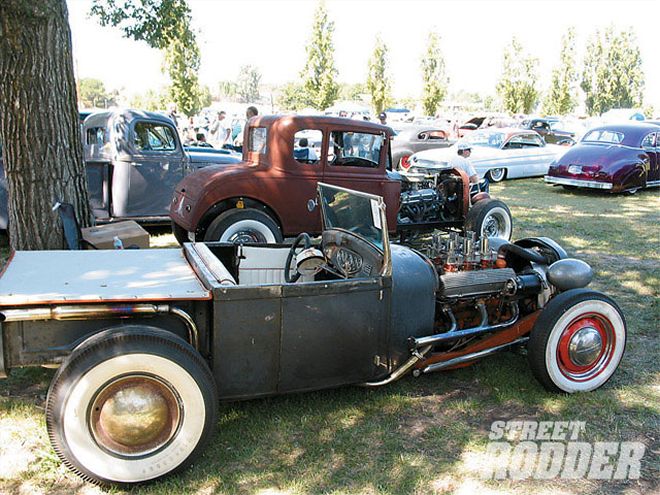 This very nice channeled roadster pickup is totally traditional, sporting many hard-to-find period accessories. The builder could have installed a new Goodwrench 350 and added a generator and Corvette valve covers as if it were a '57 283, but the car wouldn't have the additional impact of this Olds engine with 6x2 carburetion.
This very nice channeled roadster pickup is totally traditional, sporting many hard-to-find period accessories. The builder could have installed a new Goodwrench 350 and added a generator and Corvette valve covers as if it were a '57 283, but the car wouldn't have the additional impact of this Olds engine with 6x2 carburetion.
Identifying Olds engines can be confusing, even for aficionados. The 303s are easy, as they are the only ones with round exhaust ports; all later engines have rectangular exhaust ports. There are enough variations over the years in deck height, stroke, manifolds, and cam and lifter specs that there is precious little interchange between the various engines, although in the Fifties a popular swap for the early engines was switching to a pair of '56 heads for better breathing. In the years '59 and '60, where both 371 and 394 engines were available, you can tell the 394s because they have three bolts on the center exhaust flange, 371's have only two. A "loose" guide to ID's are characters cast into the cylinder head at the center exhaust port. The '49-52 engines have no number, '53s have either a #3 or #5, '54-55 have a #8, '56s have a #10, '57-59 have #14, #15, or #16, and the '59-63 engines have numbers from #20 through #23. This gets you in the ballpark.
Once you get a useable long-block, rebuilding an Oldsmobile Rocket is as straightforward as any other engine. Accurate machine work in the bottom end, a good balance job (note that '58 and '59 371s are externally balanced), and a precise bore-and-hone job to work with modern moly rings will reward you with an engine that can outlive you. The Olds cylinder heads work great with a standard performance treatment of bowl cleanup, ports matched to the manifolds, and a three-angle valve job. As far as airflow is concerned, Olds heads have been flow-benched and the results were as good as the SBC "292" head, plus the Olds heads are already at 18 degrees.
There are Olds engine-builders like Dave Smith Engineering (Exeter, California) and Ross Racing Engines (Niles, Ohio) who specialize in stock and performance engines, and they can trick out your Olds to the limit of your wallet, with strokers, roller rockers (Ross), forged pistons, etc., but most of us with a lightweight traditional street rod don't really need the expensive extras to light up the wide whites. For a standard rebuild, Egge Machine (Santa Fe Springs, California), Kanter Auto (Boonton, New Jersey), Speedway Motors (Lincoln, Nebraska) and other companies (see Hemming Motor News) have complete rebuild kits with pistons, cam, lifters, bearings, and all the gaskets. Most of these companies offer upgrades, too, like including moly rings instead of OEM cast-iron. Speedway has a full page of Oldsmobile rebuild and other parts in their wish book. Cams are available from Iskenderian, Clay Smith, and others who made them then and now. Make sure you use a single-pattern profile, not a dual-pattern. Speed equipment for the Rockets is surprisingly easy to find at swap meets, although much of it is for the earlier engines. Intake manifolds abound, and Offenhauser still makes their 3x2 intake and low-rise dual-quads if you don't enjoy the hunting process.
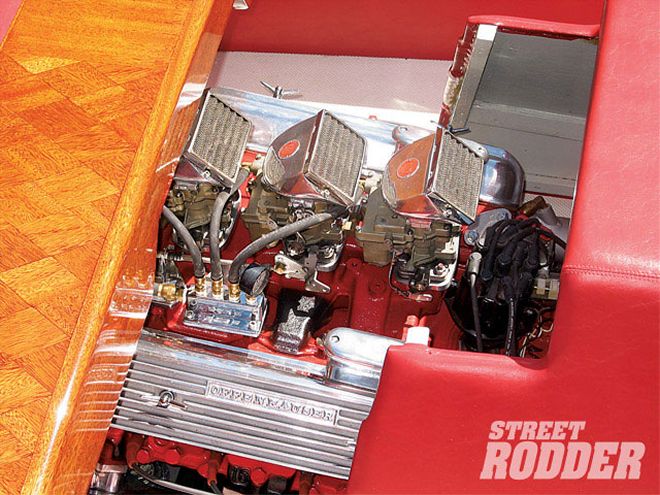 The torque and reliability of the Olds was not overlooked by the hot-boat crowd, either. In '58 and '59, Portland Boat Works built three 18-foot "specials," powered by hopped Rockets. Appropriately, the hull model was named "Gyded Missel."
The torque and reliability of the Olds was not overlooked by the hot-boat crowd, either. In '58 and '59, Portland Boat Works built three 18-foot "specials," powered by hopped Rockets. Appropriately, the hull model was named "Gyded Missel."
Installing an Olds in your street rod is similar to the mounting of a Ford Y-block, in that they used a single front mount under the crank dampener and two side mounts off the bellhousing. You can use this arrangement if you like, but Hurst and other companies made mounts that bolted to the front of the engine and extended outward to meet their brackets at the frame rails. These are getting expensive now, but if you can build a street rod, making some simple side-mounts should be no problem. If you use a modern trans behind a Rocket, you can then use a simple, single mount at the rear. Modern bellhousings are available that have the mounting ears for a stock installation in an Olds. No one makes a basic tubular header for the early Olds motors, but that's fine with most rodders, who either build outside headers or use stock iron manifolds, which cling quite tightly to the block. The starter is on the left, on a removable cast-iron lower section of the engine's rear bell. This was a problem in rods using early Ford steering boxes, but was addressed in the old days with aftermarket aluminum lower bells that put the starter on the right. Finding one today isn't easy.
If there is any drawback to using an Olds engine in a street rod, it's the transmission choices. If you want a modern automatic transmission, so far the only choice is from Tanson (Sacramento, California). You send them a clean, empty case from a GM TH350, TH400, 700-R4, or 200-4R, and they will machine the front, weld on a new flange, and remachine it to fit the Olds. It's not inexpensive, and there is a wait, but it is a slick solution. Make sure your empty case has been thoroughly checked by a trans guy before you send it to Tanson.
For three-pedal guys, the situation is much better. Several companies make stick bellhousings, and Ross Racing Engines has new steel flywheels. Wilcap (San Luis Obispo, California) has an adapter set for the traditional swap of an Olds to an early Ford trans, plus a bellhousing and other parts to put most any GM stick transmission, 3-speed, four-speed, or even a T5, behind your Olds engine.
When it comes to bling for the Rockets, there's some out there in the vintage marketplace, and Offy (see Exeter Auto Supply) still makes their classic finned-aluminum valve covers. Similarly-finned valley covers are available from Eelco (see Streamline), O'Brien Truckers and Mooneyes. One note on aftermarket valley covers: if you're using an aftermarket intake it's no problem, but some OEM Olds four-barrel manifolds have a low underside section that will interfere with flat valley covers. Chroming your stock tin Olds valve covers is another great look, and if you can afford it, also chrome the front water crossover casting between the cylinder heads. Heck, dip anything removable in the tank!
The word rocket meant a lot in the '50s, implying speed and the latest in technology, and in looks, performance, reliability and character, those old Rocket Oldsmobile engines will make just as much of a statement in your next hot rod.